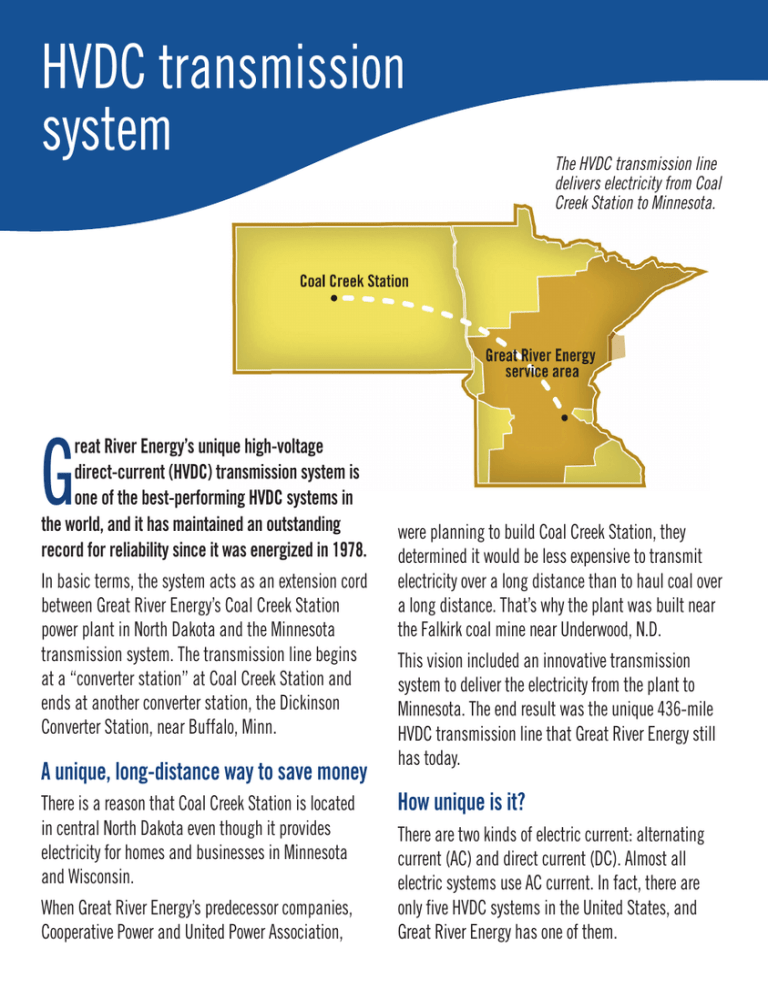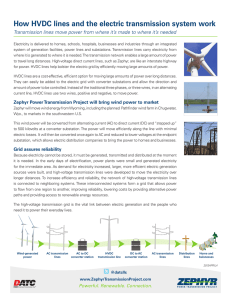View our HVDC fact sheet
advertisement

HVDC transmission system G reat River Energy’s unique high-voltage direct-current (HVDC) transmission system is one of the best-performing HVDC systems in the world, and it has maintained an outstanding record for reliability since it was energized in 1978. In basic terms, the system acts as an extension cord between Great River Energy’s Coal Creek Station power plant in North Dakota and the Minnesota transmission system. The transmission line begins at a “converter station” at Coal Creek Station and ends at another converter station, the Dickinson Converter Station, near Buffalo, Minn. A unique, long-distance way to save money There is a reason that Coal Creek Station is located in central North Dakota even though it provides electricity for homes and businesses in Minnesota and Wisconsin. When Great River Energy’s predecessor companies, Cooperative Power and United Power Association, The HVDC transmission line delivers electricity from Coal Creek Station to Minnesota. were planning to build Coal Creek Station, they determined it would be less expensive to transmit electricity over a long distance than to haul coal over a long distance. That’s why the plant was built near the Falkirk coal mine near Underwood, N.D. This vision included an innovative transmission system to deliver the electricity from the plant to Minnesota. The end result was the unique 436-mile HVDC transmission line that Great River Energy still has today. How unique is it? There are two kinds of electric current: alternating current (AC) and direct current (DC). Almost all electric systems use AC current. In fact, there are only five HVDC systems in the United States, and Great River Energy has one of them. Quick facts The HVDC transmission line: • Is 436 miles long • Contains more than 1,600 lattice steel towers • Operates at ±400 kilovolts • Transmits nearly 70 percent of Great River Energy’s power Why DC power was better than AC power Project designers chose to design the system using DC power over the traditional AC power for a number of reasons. First, when electricity is transmitted, some of the power is lost in the process and using a DC system over this long distance minimizes losses. Second, the DC system offers added reliability. For example, the system includes two independent sets of equipment, called poles. If one pole is out of service, the second pole can still continue to transmit 50 percent of the power the plant can generate. The DC system also allows for better control of power exchange and the ability to operate at a reduced voltage if necessary. Finally, choosing a DC system over an AC system helped reduce impact to property owners when the line was built. The transmission line corridor was narrower and fewer towers were needed. How it works, technically speaking Nearly all homes and businesses in the U.S. use 60-cycle AC power. That means the electrons in the conductors (the transmission line wires) alternate the direction of their flow 60 times a second. With DC power, the electrons travel through the conductors in a constant, or direct line. Regular maintenance helps keep the system reliable. Power is generated in a conventional AC generator at Coal Creek Station. A converter station located next to the power plant converts the AC electricity produced by the plant into DC power. A special device called a thyristor converts the electricity by allowing the current to pass through in only one direction, much like a check valve on a water system. Thyristors also control the amount of current flow by firing, or turning on, when ordered by the control system. Direct current Alternating current Many thyristors are connected together to construct a “valve”, which has the high power capability needed for the conversion process. There are 4,320 thyristors in each converter station. In direct current (DC), electrons travel continuously in one direction. In alternating current (AC), electrons alternate directions. Both are used in electric transmission, but AC is much more common. Incoming AC power is three-phase, which means it has three conductors with individual waveforms. Each phase is connected to two separate valves that are fired in a sequence so that the currents on the three AC phases can be added or subtracted to form the DC output of the converter. The result is a sixpulse system that produces a DC current; however, at this point, there are unacceptable levels of voltage distortion, or harmonics, which can cause operational problems on the AC system. Two six-pulse converters are then placed in a series to reduce harmonics and produce “cleaner” DC power. The power is then transmitted down the line to Minnesota. It arrives at the Dickinson Converter Station where the process works in reverse – the electricity is converted back to AC so it can be used by customers. A look inside the valve hall at the Dickinson Converter Station at the Minnesota end of the HVDC line. Also, since both converter stations contain identical equipment, if required, electricity could be converted and sent the other direction, enhancing the reliability of this unique system. The power behind your electric cooperative Great River Energy is a not-for-profit electric cooperative providing wholesale power to 28 distribution cooperatives in Minnesota and into Wisconsin. Our member cooperatives distribute that electricity to 650,000 families, farms and businesses serving approximately 1.7 million people. Great River Energy is the second largest electric utility in Minnesota and one of the largest generation and transmission cooperatives in the country. Based in Maple Grove, we own and operate 12 power plants and more than 4,600 miles of transmission line in Minnesota and North Dakota. We’re the power behind your electric cooperative. Great River Energy 12300 Elm Creek Boulevard Maple Grove, MN 55369 763-445-5000 greatriverenergy.com 04/2013




